CHIOS
History

History
Popular destinations GREECE
| Aegina | Alonissos | Andros |
| Chios | Corfu | Crete |
| Hydra | Kalymnos | Karpathos |
| Kefalonia | Kos | Lefkas |
| Lesbos | Mykonos | Naxos |
| Paros | Patmos | Peloponnese |
| Poros | Rhodes | Samos |
| Santorini | Skiathos | Skopelos |
| Spetses | Thasos | Zakynthos |
History
Prehistory
Archaeological research on Chios has shown that Chios was already inhabited at least in the Neolithic or New Stone Age (ca. 4000 BC). The most important finds from this period are cave dwellings in the north near Hagio Galas and remains of a settlement and necropolis near Emporeio in the far south of the island. However, not much is known about this period in the history of Chios. The size and the duration of these settlements on Chios are not known. What is striking is the similarity in size of the houses in Emporeio, which may indicate that there was little social distinction between the inhabitants during the Neolithic period. The inhabitants at that time most probably lived from agriculture and cattle breeding.
Archaeologists assume that Chios was not inhabited during the Middle Bronze Age (2300-1600 BC), or at least no evidence for this has been found. Others claim that there has not been enough archaeological research to draw such conclusions. What is certain is that Chios was ruled by a monarchy in about 1100 BC and then by an aristocratic or even tyrannical government for several centuries. Chios city was founded in the 11th century BC and by the 7th century BC it was already one of the most important and wealthy city-states. Ceramics from Cyprus and from the Greek island of Evia have been found from the 9th century BC. At the same time Ionian Greeks from mainland Greece settled on Chios. Around 800 BC the famous Greek poet and singer Homer is said to have been on Chios, but this has never been proved with certainty. In the 7th century BC there were contacts with Egypt, pottery found on Chios proves it.
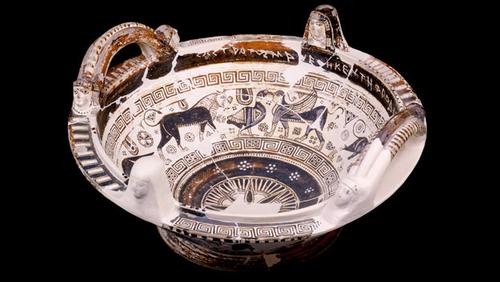 Earthenware bowl made in Chios and found in EgyptPhoto: Public domain
Earthenware bowl made in Chios and found in EgyptPhoto: Public domain
Archaic Period (800-480 B.C.) and Classical Period (ca. 500-323 B.C.)
In the 7th century BC there were contacts with Egypt, pottery found on Chios proves it. At the same time Leleges, a coastal people, settled on Chios. The Leleges, themselves subject to the Minoans of Crete, were soon driven out again by Ionian Greeks from mainland Greece. In the second half of the 6th century B.C. Chios, together with Samos among others, became members of the Ionian League (also called Panionion or Ionian Twelve-City League), a league or 'koinon' of twelve Greek cities on the Ionian or Asia Minor coast, and besides Chios also the island of Samos. The purpose of this union was to protect the territorial and economic interests against the advancing Persian Empire, which had occupied Chios in 546 BC. Chios. In the 6th century B.C. the government of Chios drew up a constitution as developed by the Athenian poet, statesman and legislator Solon in Athens. Later democratic features such as a voting parliament and popular magistrates, "demarchoi", were added.
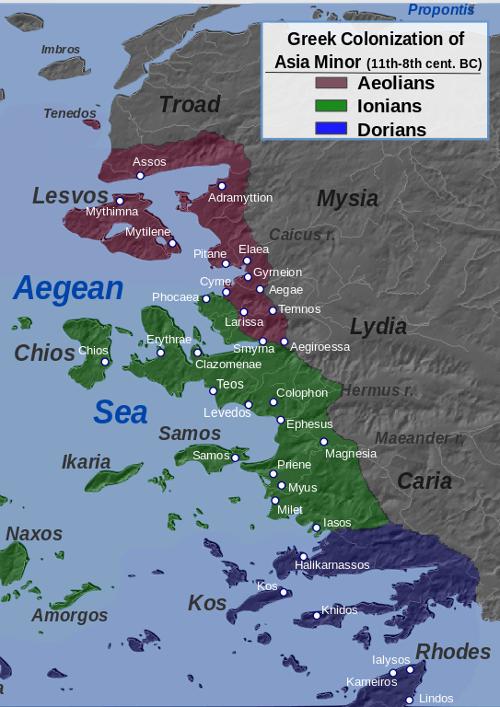 Chios Ionian Union Photo: Alexikoua CC 3.0 Unported no changes made
Chios Ionian Union Photo: Alexikoua CC 3.0 Unported no changes made
The resistance of the "League" would eventually lead to the Ionian Revolt (499-494 BC) and the Persian Wars (490-479 BC). In the Ionian Revolt the large fleet of Chios, about 100 ships, had an important role, among others in the Sea Battle of Lade in 494 BC, but the rebels could not hold out against the powerful Persian army and Chios was again occupied by the Persians. During the time of the Confederation, Chios was one of the first to mint coins, the symbol of which was a sphinx, a tradition that would last for more than nine centuries.
In 479 BC the Persians lost the Battle of Mycale and this meant that Chios was freed from Persian rule again. Chios then joined the Delian League (also called Delian Attic or Attic Delian Sea League), which was founded by Athens from 479-404 BC as a counterpart to the Peloponnesian League of Sparta. Chios, which at the time was home to some 120,000 people, did not contribute financially to the alliance, but instead supplied ships.
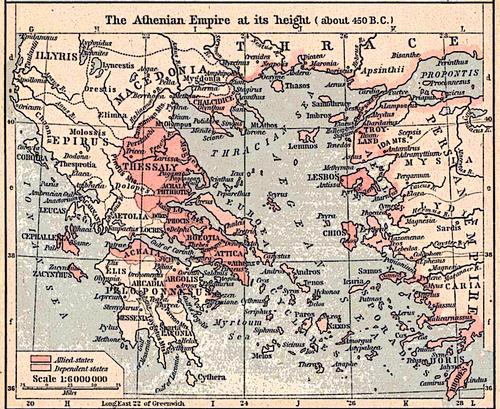 Athenian Empire at its height, ca. 450 BCE Photo: Public domain
Athenian Empire at its height, ca. 450 BCE Photo: Public domain
In 412 BC Chios rebelled against Athens during the Peloponnesian War (431-404 BC), but only managed to free itself from Athens with the help of Sparta. In 378 BC Chios rejoined the reconstituted Delian League, but along with Rhodes and Kos also rebelled against Athens during the so-called Allied War (357-355 BC). This resulted in an independent Chios until the rise of the Macedonian Empire under King Philip II, Athens was defeated by the Macedonians in the Battle of Chaeronea in 338 BC.
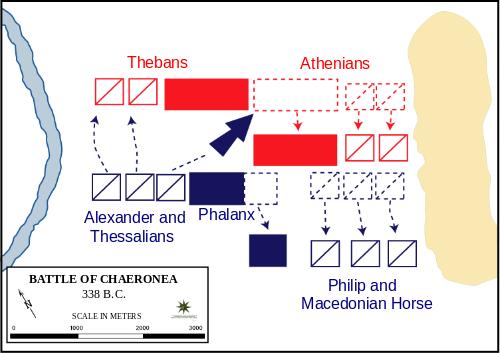 Chios Overview Battle of Chaeronea in 338 BC.Photo: Public domeain
Chios Overview Battle of Chaeronea in 338 BC.Photo: Public domeain
Hellenistic period
In the decades immediately preceding the Macedonian domination of the Greek city-states, Chios was home to a school of rhetoric founded by Isocrates (436-338 BC). After the Battle of Leuctra in 371 BC, between Sparta and Thebes, followers of the Spartans were exiled on Chios.
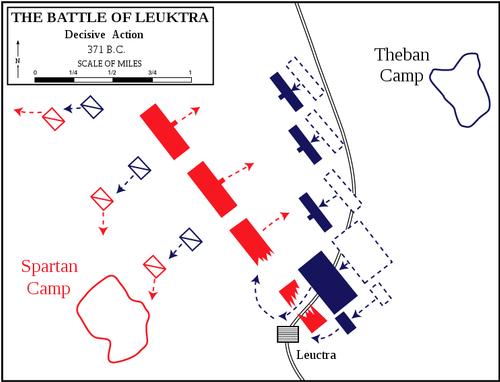 Chios Battle of Leuctra (371 BC) Photo: Public domain
Chios Battle of Leuctra (371 BC) Photo: Public domain
Among them were Damasistratus from Chios and his son Theopompus (ca. 378 BC - ca. 320 BC). The latter studied history with Isocrates in Athens and would indeed become a famous historian and orator.
After Alexander the Great invaded Asia Minor in 333 BC, Theopompus returned to Chios with the other exiles. Theopompus was later exiled again after the death of Alexander in 323 BC and took refuge in Egypt.
During the same period Chios had become the largest wine exporter in Greece, a wine of considerable quality traded in amphorae bearing the characteristic sphinx and a bunch of grapes as far as Gaul, Upper Egypt and Southern Russia.
Roman rule
During the Third Macedonian War (171-168 BC), a struggle between Rome and the Macedonian kings striving for hegemony over Greece, 35 ships containing about 1,000 Galatian soldiers and a number of horses were sent by Eumenes II of Pergamon (197-159 BC) to his brother, the king of Pergamon Attalus II Philadelphus (220-138 BC).
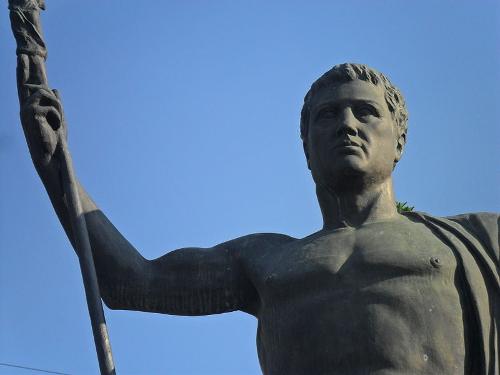 Attalus II PhiladelphusPhoto: Public domain
Attalus II PhiladelphusPhoto: Public domain
This fleet set sail from the port city of Elaea in Asia Minor, now Western Turkey, towards the port of Phanae, to disembark there and march on Macedonia. However, fleet commander Antenor of King Perseus of Macedonia (c. 212-166 BC) intercepted the fleet between Erythrae, one of the twelve Ionian cities on the west coast of Asia Minor, and Chios .
According to the historian Livius, the Romans were completely overrun by Antenor. The officers of Eumenes even thought at first that they were allies of the Romans, but were completely surprised when it turned out that it was the Macedonian enemy. Some fled from the ships and swam to Erythrae, others abandoned their ships and fled to Chios-city. The inhabitants of Chios-city, however, closed their gates and then it was not difficult for the Macedonians to crush the Galatian army; 800 of the 1000 soldiers were killed and 200 were taken prisoner. After the Roman conquest in 146 BC Chios became part of the province of Asia.
Byzantine rule
After the final division of the Roman Empire in 395 AD, Chios was part of the Byzantine Empire for six centuries. This came to an end when the island was briefly occupied (1090-1097) by Tzachas, a Turkish bey from the Smyrna region during the Turks' first occupation of the Aegean coast. Tzachas' fleet conquered Lesvos in 1089 and Chios in 1090, and then the Byzantine fleet of Niketas Kastamonites was defeated at Oinousses, a neighbouring island of Chios. In 1091 Samos and Rhodes were also conquered by Tzachas, but the Turks were soon driven out by the Byzantines led by the prominent admiral Constantine Dalassenos (c. 1086-1093) and aided by the Crusaders of the First Crusade. Tzachas suffered a crushing defeat in the Sea of Marmara and in 1092 his entire fleet was destroyed by Delanassos and Johannes Doukas, another famous Byzantine soldier of the time.
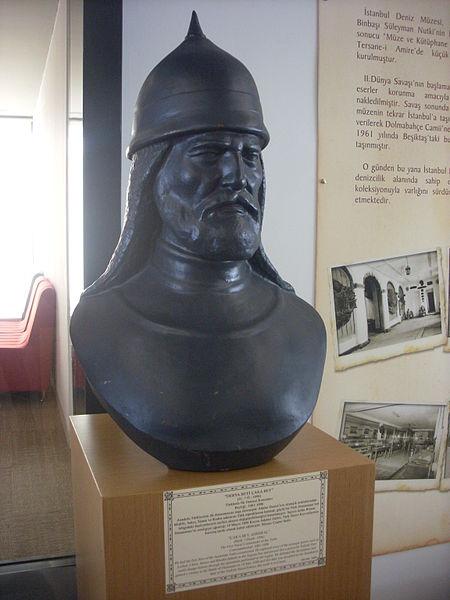 Bey Tzachas Chios Photo: VikiPicture CC 3.0 Unported no changes made
Bey Tzachas Chios Photo: VikiPicture CC 3.0 Unported no changes made
The relative stability that was then established came to an end with the Fall of Constantinople in 1204 after the Fourth Crusade, and during the turmoil of the 13th century Chios was always the victim of a regional power struggle between the Nicea Empire, the Trebisian Empire and the Epirus Dispossession. Chios finally became part of the Nicea Empire (1204-1261)
Genoese and Ottoman domination
The Byzantine rulers had little influence and by the Treaty of Nymphaeum, power over Chios was transferred to the Republic of Genoa in 1261. During this time Chios was also frequently attacked by pirates, and in 1302-1303 the island was again a target for the renewed Turkish fleet. To prevent renewed Turkish domination, the island was recaptured in 1304 on behalf of the Byzantine Emperor Andronicus II Paleologus by the Genoese Benedetto I Zaccaria (c. 1235-1307). Zaccaria installed himself as a meek ruler of Chios, and effective control of the island remained in the hands of Greek landowners. Zaccaria was succeeded by his son Paleologo and then by grandsons or nephews such as Benedetto II and Martino. They did try to free Chios from the dominant Byzantine influences and focus more on the Latin and Papal powers. However, the local population still remained loyal to the Byzantine Empire and expelled the Zaccaria family from the island in 1329.
This local hegemony lasted but a short while, in 1346 a chartered 'company' or Maona, the "Maona di Chio e di Focea", was established in Genoa to exploit Chios and the neighbouring city of Phocaea in Asia Minor. Although the islanders resisted strongly and refused an initial offer of protection, Chios was conquered by a Genoese fleet commanded by Simone Vignoso and administered by the Giustiniani family of Genoa. Once again, power over the island was settled peacefully and a treaty was signed with the Greek landowners, maintaining all privileges as long as the authority of Genoa was accepted.
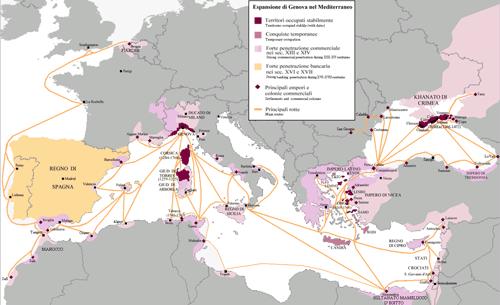 Expansion of Genoese Empire Chios Photo: Kayac71 CC 3.0 Unported no changes made
Expansion of Genoese Empire Chios Photo: Kayac71 CC 3.0 Unported no changes made
Genoa, more interested in making profits than in conquering Chios, controlled the trading posts and the warehouses, especially the trade in mastic, alum, salt and pine resin. Trade in grain, wine and textiles was carried out jointly with the local population. However, in 1347 the people of Chios rose up against the occupiers, but this rebellion failed and Genoa remained in control of the island, but allowed total freedom of religion. In this way Chios remained under Genoese control for another two centuries.
By the early 15th century, Asia Minor and many Aegean islands were in Ottoman hands, but Chios remained under the control of Genoese families. For this they paid a sum of money to the Ottoman Sultan. In the 16th century, Genoa's power and prestige declined as a result of declining trade and the local Genoese rulers on Chios were gradually absorbed by the local population. Chios remained in Genoese hands until 1566, when the Sultan realised that Chios was a perfect base for Western attacks on Constantinople. Not much later Chios was occupied by Ottoman troops and incorporated into the Ottoman Empire.
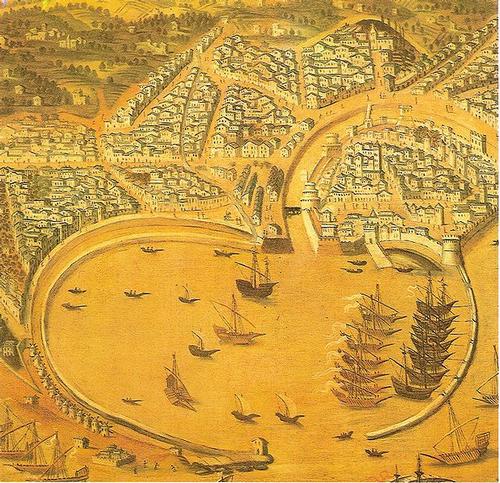 Chios in the 16th century Photo: Public domain
Chios in the 16th century Photo: Public domain
Nevertheless, Chios retained some autonomy, for the Genoese families were eventually replaced by so-called Fanarians, Greek intellectuals who worked as high officials within the Ottoman Empire. Eventually, these Fanarians would play an important role in the emerging Greek nationalism and the consequent Greek independence in 1821.
19th century
When the Greek War of Independence broke out, the leaders of Chios were reluctant to help the independence fighters in their struggle, afraid of risking their safety and prosperity under the Ottomans. But everything changed when a few hundred armed Greeks from the island of Samos set foot on Chian soil. They called for revolution and attacked the Ottomans, after which the inhabitants of Chios sided with the Samotians and joined the fight.
Then the Ottoman Sultan Mahmud sent a large army to Chios and crushed the rebellion with brute force and much bloodshed. In the "Chios Massacre", 100,000 of the 120,000 inhabitants, including women, children and hundreds of monks from the Nea Moni monastery, were expelled from the island, killed or enslaved. Entire villages were wiped off the map, including several mastic villages in the south.
The islet of Psara, a three-hour boat ride from Chios town, was also badly hit. In 1824, almost all the inhabitants of the island were killed by Turkish Janissaries in a matter of hours. A few hundred residents of Psara survived the massacre, but fled elsewhere. Psara then remained uninhabited for several decades.
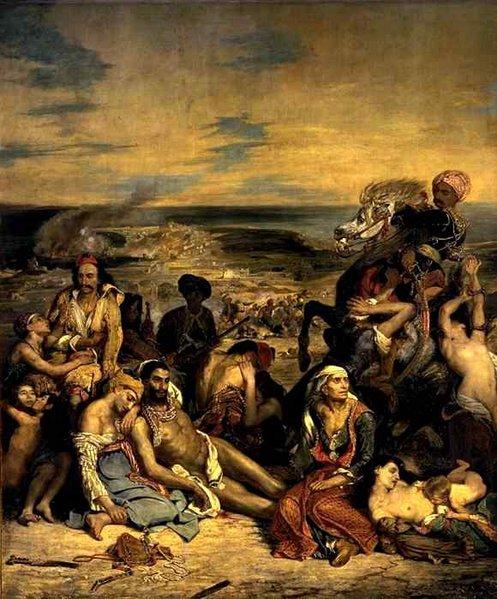 Eugène Delacroix's painting of the Massacre on Chios Photo: Public domain
Eugène Delacroix's painting of the Massacre on Chios Photo: Public domain
In 1881, an earthquake measuring 6.5 on the Richter scale struck Chios, causing extensive damage and between 5,500 and 10,000 deaths.
20th century
Chios joined the rest of independent Greece in 1912, after the First Balkan War. The Greek Navy liberated Chios in November 1912 after fierce battles with Turkey. Turkey recognised Chios and the other Aegean islands as Greek territory by the Treaty of London in 1913.
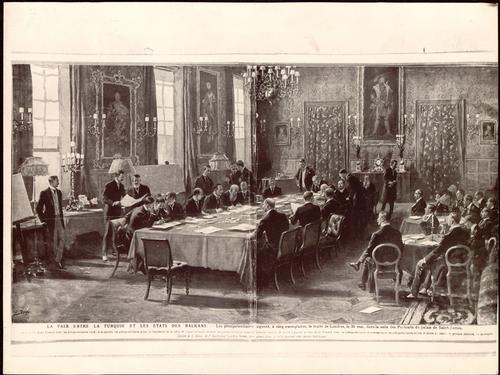 Negotiations at the London Conference in 1913, ChiosPhoto: Public domain
Negotiations at the London Conference in 1913, ChiosPhoto: Public domain
This treaty was further enforced by the migrations that started after the Greek-Turkish War of 1919-922. Turks moved to Turkey, Greek refugees settled in the former Turkish Kastro and in hastily built villages in southern Chios. During the Second World War Chios was occupied by the Germans from 1941 to 1944. Most of the Jewish population of Chios had already left for safer areas before the beginning of the Second World War.
In 1943, the local authorities warned the remaining Jews that the Gestapo had received orders to arrest all Jews and transport them to Germany. Some families were smuggled off the island, those who remained fell into the hands of the Germans and nobody has ever heard from them again. Most probably they all perished in German concentration camps.
21th century
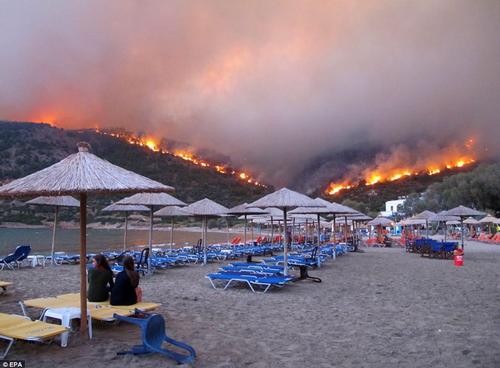 The fires could be seen from the beach at Chios Photo: Public domain
The fires could be seen from the beach at Chios Photo: Public domain
In August 2012, mastic production on Chios was severely threatened by widespread forest fires, which engulfed the southern half of the island. More than 7,000 hectares of forest, agricultural land and mastic orchards were totally destroyed. Due to its proximity to Turkey, Chios was inundated with migrants during the refugee crisis since 2015.
Sources
Wikipedia
CIA - World Factbook
BBC - Country Profiles
Last updated November 2025Copyright: Team The World of Info